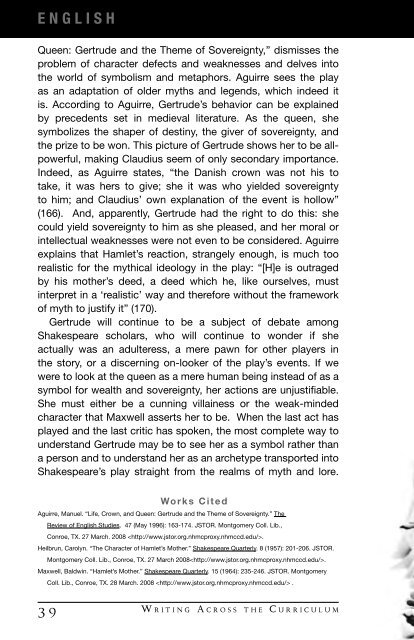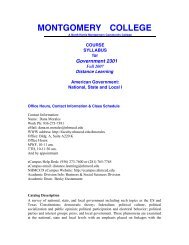2008 - Communication Across the Curriculum (CAC)
2008 - Communication Across the Curriculum (CAC)
2008 - Communication Across the Curriculum (CAC)
Create successful ePaper yourself
Turn your PDF publications into a flip-book with our unique Google optimized e-Paper software.
E n g l i s h<br />
Queen: Gertrude and <strong>the</strong> Theme of Sovereignty,” dismisses <strong>the</strong><br />
problem of character defects and weaknesses and delves into<br />
<strong>the</strong> world of symbolism and metaphors. Aguirre sees <strong>the</strong> play<br />
as an adaptation of older myths and legends, which indeed it<br />
is. According to Aguirre, Gertrude’s behavior can be explained<br />
by precedents set in medieval literature. As <strong>the</strong> queen, she<br />
symbolizes <strong>the</strong> shaper of destiny, <strong>the</strong> giver of sovereignty, and<br />
<strong>the</strong> prize to be won. This picture of Gertrude shows her to be allpowerful,<br />
making Claudius seem of only secondary importance.<br />
Indeed, as Aguirre states, “<strong>the</strong> Danish crown was not his to<br />
take, it was hers to give; she it was who yielded sovereignty<br />
to him; and Claudius’ own explanation of <strong>the</strong> event is hollow”<br />
(166). And, apparently, Gertrude had <strong>the</strong> right to do this: she<br />
could yield sovereignty to him as she pleased, and her moral or<br />
intellectual weaknesses were not even to be considered. Aguirre<br />
explains that Hamlet’s reaction, strangely enough, is much too<br />
realistic for <strong>the</strong> mythical ideology in <strong>the</strong> play: “[H]e is outraged<br />
by his mo<strong>the</strong>r’s deed, a deed which he, like ourselves, must<br />
interpret in a ‘realistic’ way and <strong>the</strong>refore without <strong>the</strong> framework<br />
of myth to justify it” (170).<br />
Gertrude will continue to be a subject of debate among<br />
Shakespeare scholars, who will continue to wonder if she<br />
actually was an adulteress, a mere pawn for o<strong>the</strong>r players in<br />
<strong>the</strong> story, or a discerning on-looker of <strong>the</strong> play’s events. If we<br />
were to look at <strong>the</strong> queen as a mere human being instead of as a<br />
symbol for wealth and sovereignty, her actions are unjustifiable.<br />
She must ei<strong>the</strong>r be a cunning villainess or <strong>the</strong> weak-minded<br />
character that Maxwell asserts her to be. When <strong>the</strong> last act has<br />
played and <strong>the</strong> last critic has spoken, <strong>the</strong> most complete way to<br />
understand Gertrude may be to see her as a symbol ra<strong>the</strong>r than<br />
a person and to understand her as an archetype transported into<br />
Shakespeare’s play straight from <strong>the</strong> realms of myth and lore.<br />
Works Cited<br />
Aguirre, Manuel. “Life, Crown, and Queen: Gertrude and <strong>the</strong> Theme of Sovereignty.” The<br />
Review of English Studies. 47 (May 1996): 163-174. JSTOR. Montgomery Coll. Lib.,<br />
Conroe, TX. 27 March. <strong>2008</strong> .<br />
Heilbrun, Carolyn. “The Character of Hamlet’s Mo<strong>the</strong>r.” Shakespeare Quarterly. 8 (1957): 201-206. JSTOR.<br />
Montgomery Coll. Lib., Conroe, TX. 27 March <strong>2008</strong>.<br />
Maxwell, Baldwin. “Hamlet’s Mo<strong>the</strong>r.” Shakespeare Quarterly. 15 (1964): 235-246. JSTOR. Montgomery<br />
Coll. Lib., Conroe, TX. 28 March. <strong>2008</strong> .<br />
3 9<br />
W r i t i n g A c r o s s t h e C u r r i c u l u m






